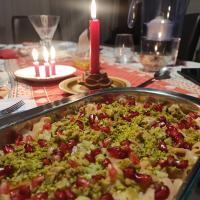Copy Link
Add to Bookmark
Report
Mead Lovers Digest #0308

Subject: Mead Lover's Digest #308, 19 May 1994
From: mead-lovers-request@eklektix.com
Mead Lover's Digest #308 19 May 1994
Forum for Discussion of Mead Making and Consuming
Dick Dunn, Digest Coordinator
Contents:
administrivium: if mail bounced on 5/17, re-send (Dick Dunn)
citric acid in mead (Jay Hersh)
Citric acid, bisulfites (Kelly Jones)
orange peel, citric acid (Dick Dunn)
Lalvin K1 yeast, citric acid (Brian Smithey)
Re: Mead Lover's Digest #307 (Thomas_Fotovich-U2347@email.mot.com)
Re: orange peel (Jane Beckman)
Send ONLY articles for the digest to mead-lovers@eklektix.com.
Use mead-lovers-request@eklektix.com for subscribe, unsubscribe, and admin
requests. When subscribing, please include your name and a good address
in the message body unless you're sure your mailer generates them.
There is an FTP archive of the digest on sierra.stanford.edu in pub/mead.
If you have email access but not ftp, it will accept "listserv" requests.
Send email with message "help" to listserv@sierra.stanford.edu.
------------------------------
Subject: administrivium: if mail bounced on 5/17, re-send
From: rcd@raven.eklektix.com (Dick Dunn)
Date: 18 May 94 10:04:40 MDT (Wed)
Our Internet service provider bounced some mail mid-day (MDT) on Tuesday,
5/17. If you tried to submit something to the Digest then and it bounced,
please resubmit. Sorry for the trouble, but it was beyond my control.
---
Mead-Lover's Digest mead-lovers-request@eklektix.com
Dick Dunn, Digest Coordinator Boulder, Colorado USA
------------------------------
Subject: citric acid in mead
From: Jay Hersh <hersh@x.org>
Date: Wed, 18 May 1994 14:42:22 EDT
> The orange peels probably had ALOT to do with it ! The addition of any
>citric acid to a must is not good.Citric acid blocks the EMP pathway enzymes
> ( glycolysis ) and as a result slows or even stops alcoholic fermentation.
>This is esp. important at the begining, since it is starting aerobically.
>Additionally, lactic acid bacteria love citric acid, creating acetic acid....
>( and NO, busulfites have no inhibitory effect on acetic / lactic acid
>bacteria )
funny, up until the last mead I made every one had some type of fruit, or
fruit juice or essence, i.e. they contained a good amount of citric acid.
In fact most acid blends that mead makers use contain citric acid.
I strongly question the validity of this statement since virtually every mead
I have ever had that was a home made one had either fruit in it, or a acid
blend used in its production.
JaH
------------------------------
Subject: Citric acid, bisulfites
From: Kelly Jones <k-jones@ee.utah.edu>
Date: Wed, 18 May 94 13:47:01 -0600
In MLD #307, MEADMSTR@aol.com said:
The orange peels probably had ALOT to do with it ! The
addition of any citric acid to a must is not good.Citric acid
blocks the EMP pathway enzymes
( glycolysis ) and as a result slows or even stops alcoholic
fermentation.
This strikes me as odd. I believe that Morse is a proponent of using
citric acid and citrates as a pH adjuster/buffer, and reports faster
ferments when doing this. Even so, how much citric acid is in orange
peels? I thought the skins contained mostly essential oils, the
citric acid is in the juice.
Additionally, lactic acid bacteria love citric acid, creating
acetic acid.... ( and NO, busulfites have no inhibitory
effect on acetic / lactic acid bacteria )
This too strikes me as odd, as it goes against everything I have read
or experienced: That bisulfites _do_ have an inhibitory effect on
most bacteria, including acetobacter aceti. What are your references
for this?
Kelly
------------------------------
Subject: orange peel, citric acid
From: rcd@raven.eklektix.com (Dick Dunn)
Date: 18 May 94 16:37:44 MDT (Wed)
MEADMSTR@aol.com wrote:
> >>--Peter Voelker (pv120859@hvcc.edu)The only thing I did different >>in this
> batch was that I put the orange peel in with the yeast >>instead of after
> fermentation was done.Is this what caused it to >>stop?
>
> The orange peels probably had ALOT to do with it ! The addition of any
> citric acid to a must is not good...[description of mechanism]...
I see two problems with this reasoning. The first is that orange peel,
_per_se_, doesn't have much citric acid in it. Also, the use of orange or
lemon peel (zest, actually--the colored outside of the peel, without the
pith) is not unusual for meads and metheglins.
Second, even if you did have a significant amount of citric acid in the
must, this is (empirically) not a problem: Lemon juice is a common
addition to mead for tartness, and I know that people actually make orange
wines (country-wine style), which would have a lot of citric acid. Beyond
that, normal acid blend (which people often use to acidify the must if
they're not adding fruit) is a combination of citric, tartaric, and malic
acids.
---
Dick Dunn rcd@eklektix.com -or- raven!rcd Boulder, Colorado USA
------------------------------
Subject: Lalvin K1 yeast, citric acid
From: Brian.Smithey@Central.Sun.COM (Brian Smithey)
Date: Wed, 18 May 1994 14:55:20 -0600
In MLD #307, there is discussion about Lalvin K1 yeast, stuck
fermentations, and citric acid.
Kevin Martin writes:
> From: Kevin V Martin <kmartin@magnus.acs.ohio-state.edu>
> Date: Tue, 17 May 94 8:36:43 EDT
>
> Peter Volelker is having a problem with Lalvin K1 yeast. I had a stuck
> fermentation with this same yeast. I added some generic ale yeast, and the
> mead took off like a shot! I have some friends who make great mead with this
> yeast, but this is the second time I've had problems with it. I am going to
> stick with ale yeasts that I know work for now on. Just my humble opinion.
I'm using K1 for the first time in a batch that I just started on
Sunday, and it's going great. 1.5 tsp nutrient and 2 tsp acid blend
in 3.5 gallons, and LOTS of aeration. There's absolutely no foam
on the top of the must, but I've been getting a "glug" out of the
airlock every 5 seconds or so since about 10 hours after pitching.
And this is at a basement temperature of about 63 F, I imagine that
it'd be really ripping if it were closer to 70 F. I'd just like to
point out that lots of aeration of the cold (pre-pitch) must, along
with an adequate quantity of properly rehydrated yeast (I use 2x 5 g.
packets of dried yeast for my 3 gallon batches, and would probably use
3 packets if I were doing 5 gallons) seems to get my meads off to a
good start every time, and I've never seen one stick, even at my usually
sub-65 fermentation temps.
Kevin and Peter, I'd be interested in hearing more about your stuck
fermentation situations -- how much yeast, did you rehydrate, areation,
fermentation temps, etc. It'd be nice to figure out if there was
something that the K1 was particularly unhappy about.
MEADMSTR@aol.com writes:
> From: MEADMSTR@aol.com
> Date: Tue, 17 May 94 21:14:35 EDT
>
>>--Peter Voelker (pv120859@hvcc.edu)The only thing I did different
>>in this batch was that I put the orange peel in with the yeast
>>instead of after fermentation was done.Is this what caused it to
>>stop?
>
> The orange peels probably had ALOT to do with it ! The addition of any
> citric acid to a must is not good.Citric acid blocks the EMP pathway enzymes
> ( glycolysis ) and as a result slows or even stops alcoholic fermentation.
> This is esp. important at the begining, since it is starting aerobically.
> Additionally, lactic acid bacteria love citric acid, creating acetic acid....
> ( and NO, busulfites have no inhibitory effect on acetic / lactic acid
> bacteria )
This surprises me a bit -- why do wine "acid blends" contain any
citric acid if this is a problem? The blend I use is citric,
malic, and tartaric acid. I've always used a bit of this acid
blend in my meads (sometimes too much :-) and haven't noticed
any fermentation problems. I'm not a wine maker, are wines usually
acidified post-ferment? I've never seen any mention of citric
acid being a fermentation inhibitor, and have assumed that mead
recpies that call for acid addition, whether wine acid blend or
lemon juice, wanted the acid in the pre-ferment must along with
everything else.
Sorry that was so long ...
Brian
--
Brian Smithey / Sun Microsystems / Colorado Springs, CO
smithey@rmtc.Central.Sun.COM
------------------------------
Subject: Re: Mead Lover's Digest #307
From: Thomas_Fotovich-U2347@email.mot.com
Date: 18 May 94 16:12:00 -0500
>>>--Peter Voelker (pv120859@hvcc.edu)The only thing I did different
>>>in this batch was that I put the orange peel in with the yeast
>>>instead of after fermentation was done.Is this what caused it to
>>>stop?
>(MEADMSTR@aol.com) replied:
>The orange peels probably had ALOT to do with it ! The addition of
any citric acid to a must is not good.Citric acid blocks the EMP
pathway enzymes ( glycolysis ) and as a result slows or even stops
alcoholic fermentation. This is esp. important at the begining, since
it is starting aerobically. Additionally, lactic acid bacteria love
citric acid, creating acetic acid.... ( and NO, busulfites have no
inhibitory effect on acetic / lactic acid bacteria )
????????
I routinely add acid blend to my mead. Last I checked acid blend
contained citric acid (could be wrong, but I don't think so).
I have noticed three problems with stuck mead fermentation. The first
is little or no nutrients were added to the honey before the yeast was
pitch. I have always added nutrient to my mead. The second is low
yeast pitch volume. (I have noticed, though, if I shake a "stuck"
fermentation, the fermentation takes off again.) The third is the
fermentation is not stuck just ssllooooowwww.
#include <standard.disclaimer>
Paddy Fotovich
Motorola UDS
u2347@email.mot.com
------------------------------
Subject: Re: orange peel
From: jane@swdc.stratus.com (Jane Beckman)
Date: Wed, 18 May 94 17:40:09 PDT
> The orange peels probably had ALOT to do with it ! The addition of any
>citric acid to a must is not good.Citric acid blocks the EMP pathway enzymes
> ( glycolysis ) and as a result slows or even stops alcoholic fermentation.
Hmm, I've actually had fairly good results putting orange peel in with
the yeast in the past, along with orange *juice* and lemon juice/peel.
One or two batches have blown corks on getting exposed to heat when
improperly stored, but that was about it. My fermentation was pretty
reasonable.
The difference I did notice (which I *like*) was the citrus peel/juice seems
to give a lighter finish to the overall character. More dry, less sweet
and syrupy. One of the things I don't like about a lot of commercial mead
is that it's way too sweet for my taste. Sometimes I like a sweet dessert
mead, but mostly I prefer a light, dry mead, for regular drinking.
Personal taste, I guess.
---Jilara [jane@swdc.stratus.com]
------------------------------
End of Mead Lover's Digest #308























